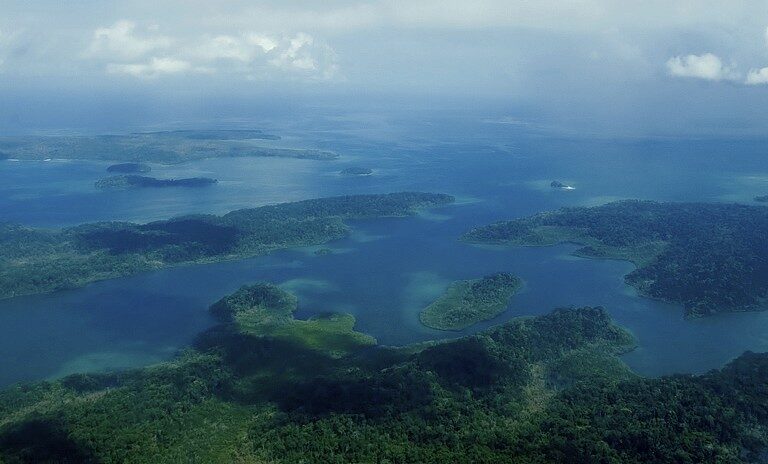- India’s environment ministry released the methodology for generating green credits from tree planting.
- Experts raised concerns about the environmental soundness of the scheme, as well as possible regulatory gaps that the methodology doesn’t address.
- The tree planting methodology includes fewer details compared to its draft version and leaves out important information about plant survival and tenure of project.
On February 22, the Ministry of Environment, Forests and Climate Change (MOEFCC) released a detailed methodology for a component of its Green Credit Programme, effectively enabling the trade of environmental benefits arising from tree planting.
The Union government calls the programme an “innovative market-based mechanism designed to incentivise voluntary environmental actions across diverse sectors.” But environmentalists and policy experts are wary about the extent to which market forces can support conservation and sustainability goals. The fine print of the scheme says the objective is to “encourage industries, companies and other entities to meet their existing obligations,” under current compliance laws, while also encouraging “other persons and entities” to participate voluntarily.
The methodology, issued in February, encourages large-scale tree planting on open forests and scrub lands, among other land types, to generate credits. These credits can be bought to meet obligations under Corporate Social Responsibility (CSR) and Environmental, Social, and Governance (ESG). They can also be exchanged to meet compensatory afforestation requirements under the Forest (Conservation) Act, which makes it mandatory for project developers to raise plantations at an alternate site for cutting down trees on forest land.
Launched in October 2023, the Green Credit Programme aims to create tradable credits from a range of activities, such as reducing air pollution and incorporating sustainable infrastructure. The Ministry had sped up the process of officiating the scheme by cutting down the window for civil society and others to submit their objections and suggestions to the scheme.
“The Green Credit Programme is trying to do some pioneering work on inter-sector fungibility, and to build a national market in which there is fungibility in green actions. This is important because what we’re trying to do is create equivalence and deliver the same value to various actors,” said Swapan Mehra, founder and CEO of IORA Ecological solutions, an environmental consultancy firm that helped design and conceptualise the Green Credit Programme.
“With tree planting, even if initially it is linked to forest department lands and regulations like CSR, the long-term goal is to incentivise these contributions voluntarily, so that entities want to contribute towards sustainability,” he added.
A new Green Credit website set up by the government says there are already 267 “registered plantation blocks”, amounting to over 17,000 hectares of land available for tree planting, as on March 18.

The government has plans of showcasing its leadership with the Green Credit Programme on an international stage, with the Global Green Credit Initiative. However, the initiative has raised several concerns domestically. Experts Mongabay India spoke to raised concerns about the environmental soundness of the scheme, as well as possible regulatory gaps that the tree planting methodology doesn’t directly address.
Departure from draft guidelines
The final methodology to generate green credits through tree planting departs significantly from its draft version, which included more details about how the scheme would operate.
According to the final methodology, forest and state departments will identify and “make available” degraded land, open forests, scrub lands, wastelands and catchment areas for large-scale tree plantations. Each tree planted on such land generates one credit and the minimum area of land eligible under the scheme is five hectares.
Participants must pay the forest department to raise the plantations and credits will be issued by the Indian Council of Forestry Research and Education (ICFRE) after the plantations are evaluated. The methodology does not describe the criteria that the plantations will need to meet in order to secure approval, only that it must hold 1100 trees per hectare of land, which some ecologists have said may exacerbate degradation. Mehra agreed the stipulation on density of saplings per hectare could be less stringent. “The number of saplings per location should be allowed to be slightly flexible, because in some cases, putting 1100 per hectare might be difficult for certain types of species and land types.”
The final methodology leaves out several details that were incorporated in the original draft, which laid an emphasis on contributions of individuals, co-operatives and small land-holding farmers. The draft had proposed the credits be issued progressively over 10 years, depending on the survivability of the plants as well as evidence of their maturation. It also suggested the minimum number of trees planted per hectare be 100, and the maximum 1000. The draft methodology even considered issuing credits on a gradient across different rainfall zones, with a list of appropriate forestry and horticulture species that can be planted. None of these details, however, made it to the final version.
“The methodology uses a tree-for-tree approach without considering the cultural importance or ecosystem services provided by forests and land,” said Meenakshi Kapoor, an independent environmental researcher who closely tracks changes to India’s environmental norms. The newly launched Green Credit website says the credits will be issued within two years of the forest department completing the plantation – a detail that doesn’t find mention in the final notified methodology. “How will these plantations survive in the long term? The methodology doesn’t address this,” Kapoor added.

Large-scale plantation programmes, managed by state forest departments, have been marred by poor monitoring and compliance. An investigation into state afforestation programmes by news website Scroll found that several plantations existed only on paper. A 2013 report by the Comptroller Auditor General (CAG) also noted serious discrepancies in compensatory afforestation efforts by states.
In a letter issued on March 19, a group of 91 retired civil servants wrote to the MOEFCC calling the scheme “unscientific.”
“Compensatory afforestation plantations already undertaken in our country are known to have dubious success rates. At any rate, the government also has huge unspent funds for such afforestation programmes and does not need further investment from any private agency. It would be a much better plan to merely protect and restore these degraded lands to their original condition,” the civil servants wrote in their letter, shared with the media.
Links to the carbon market
The Green Credit Programme will run parallel to the domestic carbon market, but the rules suggest that some activities can be shared by both green credits and carbon credits. Since activities generating green credits “may have climate co-benefits…an activity generating green credit under Green Credit programme may also get carbon credit from the same activity,” the rules say.
Experts say that the Green Credit Programme’s intended linkages with India’s upcoming carbon market, as well as its applicability to compensatory afforestation requirements, could prove to be tenuous without rigorous regulations. The objective of India’s domestic carbon market is to reduce carbon emissions from key sectors. Trees and forests have a potential role to play by acting as carbon sinks that absorb and store carbon.
“Without proper regulation, it could turn into a problem of additionality in the carbon market,” Trishant Dev, programme officer of climate change at the Centre for Science and Environment and co-author of the report Discredited, which investigated the operations of the international voluntary carbon market in the country, told Mongabay India. In carbon markets, “additionality” refers to the assurance that emissions reductions, achieved through the sale of carbon credits, would not have happened without financial support from those credits. “If an activity has already been compensated for through the exchange of green credits, the question then is, how can the same activity be compensated for by another entity in exchange for carbon credits? It would be a violation of the principle of additionality,” Dev explained.
Mehra says the Green Credit Scheme doesn’t support double counting, but encourages “double claiming,” as a way of enhancing the monetary value of planting trees, particularly for small land-holders who have not had access to the carbon market due to high transaction costs. “Double claiming is when you can claim multiple forms of payment for different services rendered by the same asset. This is different from double counting, where the same commodity is sold twice,” he said, adding, “There cannot be double counting because the Green Credit Programme doesn’t monetise carbon. On additionality, existing carbon market standards require that the project not be part of any other markets, in which case the landowner can see which, carbon credits or green credits, gives them higher value. The cash flows of a project will also reveal how much was funded by the green credit programme, and if it exceeds the threshold of the requirements in the carbon market, it can be deemed non-additional.”
Mehra believes that as the programme evolves, a distinction will emerge between green credits generated on forest department land and community-owned land, with differing implications on additionality.

The methodology for tree planting also says green credits generated “may be exchanged for meeting the compliance of the compensatory afforestation,” under the Forest (Conservation) Act.
In 2022, the rules for compensatory afforestation were altered to allow private entities and individuals to raise plantations and sell them to project developers looking to compensate for the forest-loss caused by their projects. These plantations would need to be at least five years old, spread across 10 hectares or more, with a canopy density of 40%. The green credit methodology doesn’t suggest how this will be rationalised with its own stipulation of selling credits two years after the plantation is established.
“The methods don’t talk about who will bear the risk if the plantations fail. If a credit is being issued, how can it be taken back? The methodology needs to make the question of who will bear risk clear.” said Dev. “Operating both a carbon market, and a green credit market will require a sophisticated regulatory set-up. For instance, maintaining registries and then also ensuring that there is some interoperability between them, so there’s no duplication,” he added.
Pressure on ‘wastelands’
Ecologists have long questioned the rationale of raising plantations on degraded land and other open landscapes. In a recent op-ed about the green credit programme, ecologists Anuja Malhotra and Abi T. Vanak, with Ashoka Trust for Research in Ecology and the Environment, wrote the biogeography of the land should be taken into consideration when planning plantations.

“It should explicitly mention the measures that need to be taken to make land suitable (such as soil restoration) and must safeguard against the removal of existing natural vegetation. It should also ensure that natural ecosystems such as savanna grasslands, marshes, scrub forests, deserts, rocky outcrops and glades, which are currently misclassified and viewed as non-productive/marginal systems, are not harmed,” they wrote.
Tree plantations on arid land have also proven to be expensive with poor survival rates in states like Himachal Pradesh, where incorrect species are planted on unviable land parcels.
“Restoration efforts tend to target sites that are highly degraded, in terms of both ecosystem structure and floristic composition, while sites that appear less degraded, at least in terms of structure, receive less attention,” said Anand Osuri, a researcher with the Nature Conservation Foundation (NCF) who works on eco-restoration.
New research by NCF from the Western Ghats shows that even these seemingly less-degraded forests can prove to be important arenas for restoration. Their study suggests that such forests offer substantial opportunities for broadening restoration efforts, conserving threatened tree species, and enhancing long-term carbon storage.
“Focusing more on such forests for restoration can reduce the demand on agricultural lands and open natural ecosystems for meeting restoration targets and it can create opportunities for restoring forest-specialist species,” Osuri added.
Read more: Green credit scheme encourages ‘environment-friendly’ behaviour, but needs strong regulation to work
Banner image: A photo of three men planting a tree. Photo by Nandkumarpatel/Wikimedia Commons.














